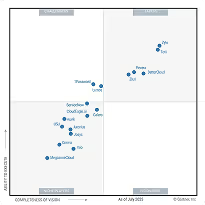HIPAA Compliance Checklist for 2025

As AI becomes central to business transformation, understanding AI pricing in 2025 is crucial. The cost of AI can vary significantly depending on factors like complexity, infrastructure, and scale.
So, how much does AI cost?
The answer depends on the model, data requirements, computing power, and ongoing maintenance. With AI adoption growing, companies need to balance innovation with cost efficiency.
Venturing into AI comes with a unique cost structure, where simple models start around $K, while complex deep learning models can range from $50K to over $100K.
Let’s explore AI pricing factors, models, and how enterprises can optimize AI spending.
TL;DR
- AI pricing in 2025 depends on factors like model type, data volume, and usage, so businesses need to understand these elements before committing.
- Token-based billing is common, where companies pay per token, API call, or compute cycle, making costs more flexible but harder to predict.
- AI pricing models include subscriptions, pay-per-use, and tiered pricing, offering flexibility but also added complexity in managing costs.
- The cost of AI also depends on model training, storage for embeddings, and fine-tuning, which can increase ongoing expenses.
- Businesses that optimize AI usage, track costs, and negotiate smart contracts will get the best ROI, keep costs predictable, and avoid hidden fees.
The Evolution of AI Pricing (2018–2025)
AI pricing has evolved from flat subscription fees to complex, usage-based models. From 2018 to 2025, AI costs shifted from fixed monthly charges to models based on performance, data, and compute power.
1. From Flat Subscriptions to Metered Usage
Initially, businesses paid a fixed rate for AI services regardless of usage. As AI models became more powerful, providers introduced metered pricing, charging based on processing time, API calls, or data volume. This shift made AI costs more transparent and scalable, especially for businesses with changing needs.
2. Rise of API Pricing (OpenAI, Anthropic, Cohere)
API-based platforms like OpenAI, Anthropic, and Cohere changed the pricing landscape. Rather than paying for software licenses, companies now pay for access to AI capabilities, billed per token, per request, or per thousand outputs. This model gives developers flexibility but makes it harder to predict AI costs over time.
3. Trends: Per-Token Pricing, Fine-Tuning Fees, and Compute Usage
By 2025, AI pricing is often based on per-token usage, with additional costs for fine-tuning, embeddings, and compute time. Customizing models increases the cost of artificial intelligence due to the extra computing and data preparation involved.
4. Impact of LLM Ops Platforms and AI Orchestration Tools
As large language models (LLMs) evolved, orchestration tools emerged to manage workloads efficiently. These platforms help optimize AI costs by automating deployments, caching, and API routing, making it easier for businesses to control costs while improving performance.
Key AI Pricing Models Explained
AI pricing combines flexibility, scalability, and performance-based billing. Understanding these pricing models is key to managing and optimizing AI costs.
Here are the most common pricing structures used today.
1. Subscription-Based Pricing
Many SaaS platforms now include built-in AI capabilities under flat subscription plans. These models make the cost of artificial intelligence predictable for smaller teams or businesses that prefer consistent monthly fees. Examples include CRM, marketing, or HR tools that embed AI features at no extra charge.
2. Pay-Per-Use / API-Based Pricing
Platforms like OpenAI, Anthropic, and Cohere popularized the pay-per-use approach, where companies pay only for what they consume. This model charges per API call or per token processed, allowing flexibility but making it harder to estimate how much AI costs over time; especially as usage grows.
3. Per-Seat Licensing with Usage Caps
In some enterprise setups, vendors offer AI pricing based on the number of users or seats, with defined usage caps. This model helps organizations control the cost of AI by limiting access to specific users, making budgeting more predictable while maintaining accountability.
4. Tiered Pricing by Model Capability
As AI models become more advanced, providers offer tiered pricing based on performance. For instance, GPT-4o, GPT-4 Turbo, and GPT-3.5 each have different AI costs per token or API call. This tiered system allows businesses to choose between speed, accuracy, and affordability, aligning pricing for AI with their operational goals.
5. Credit Systems vs. Real-Time Metering
Some vendors use credit-based systems, letting teams pre-purchase usage credits, while others employ real-time metering that bills dynamically. Credit systems offer spending control, while metered billing provides precise transparency into the cost of AI as it’s used. Both aim to balance predictability and flexibility in AI pricing models.
What’s Driving AI Costs in 2025?
The cost of AI in 2025 depends on several factors, from how models process data to how they’re deployed and governed. Understanding these factors helps businesses manage budgets and avoid hidden costs that can drive up expenses.
1. Token-Based Billing and Usage Measurement
Many AI providers now use token-based pricing, where businesses are charged for every piece of text processed. The more data an AI system handles, the higher the cost. Managing token efficiency is key to controlling AI costs.
2. Storage for Embeddings and Custom Models
Storing fine-tuned models, embeddings, and vector data adds cloud storage costs, impacting AI pricing. Efficient data management and compression can reduce these ongoing expenses.
3. Model Training and Fine-Tuning Costs
Training custom AI models requires expensive computing resources and large datasets, with costs ranging from thousands to millions of dollars depending on complexity. Fine-tuning models also significantly adds to the cost of artificial intelligence.
4. Hosting and Inference Costs
Running AI models in production requires constant hosting and processing, which uses GPU cycles. Optimizing model architecture and caching responses can help reduce these ongoing AI costs.
5. Cost of Unused AI Seats or Licenses
Many businesses over-purchase AI licenses or user seats that aren’t used, wasting money. Regular audits and usage tracking help identify and eliminate waste, ensuring investments are right-sized.
6. Legal, Compliance, and Audit Fees
Enterprises also face costs for compliance, security, and audits related to AI. These fees, often hidden in enterprise contracts, can make up 10-15% of total AI costs in regulated industries.
How Companies Are Overspending on AI?
As AI adoption grows, many companies struggle to manage its true costs. While AI offers value, inefficiencies and poor governance often lead to unnecessary waste, causing AI costs to spiral out of control.
CEO of Amazon, Andy Jassy, shares:
“AI does not have to be as expensive as it is today, and it won’t be in the future.”
1. Shadow AI and Rogue Team Subscriptions
Teams often sign up for AI tools without going through official procurement channels, creating “Shadow AI.” These unmonitored subscriptions drive up AI costs and complicate security and compliance, with duplicate licenses adding to the total expense.
2. Unused Licenses or Idle Fine-Tuned Models
Many businesses invest in fine-tuned models or bulk AI licenses that go unused. Paying for inactive users or unused compute time adds unnecessary costs. Regular audits and tracking can help identify and eliminate waste.
3. Free-Tier AI Tools Turning into Paid Subscriptions
Free AI tools often have usage limits that convert into paid plans once exceeded. Without monitoring, companies can end up with unexpected fees, raising the hidden cost of AI over time. This “freemium trap” is a common cause of overspending.
4. Misunderstood API Pricing and Runaway Token Usage
API pricing models, like OpenAI’s per-token billing, can make it hard to predict AI costs. Long prompts, fine-tuning, or unoptimized queries lead to high token usage, increasing operational costs beyond expectations.
5. No Governance Over Experimentation Costs
AI experimentation is important, but without cost controls, it can drain budgets. Research teams may run large models or projects without tracking usage. Establishing governance helps keep AI pricing transparent and avoids unnecessary overspend.
Vendor Pricing Examples in 2025
AI pricing in 2025 varies by vendor, model, and usage. Understanding how providers price their services helps estimate AI costs. Here are some typical pricing examples.
Lydia DiLiello, CEO of Capital Pricing Consultants, says,
“Artificial intelligence could cut anywhere from 30% to 70% of the time businesses spend responding to pricing/quote requests.”
1. OpenAI (GPT Models)
OpenAI continues to dominate the API market with tiered AI pricing based on model capability.
- GPT-4o: Around $0.005–$0.01 per 1,000 tokens (input) and $0.015–$0.03 (output).
- GPT-4 Turbo: Optimized for performance at nearly 40% lower AI costs.
- GPT-3.5: Still popular for budget-conscious users, costing less than $0.002 per 1,000 tokens. This flexible model allows developers to control the cost for AI based on precision and scale.
2. Anthropic (Claude Series)
Anthropic offers pricing for AI that reflects model size and context handling.
- Claude 3 Opus: Premium tier for large enterprise workloads.
- Claude 3 Sonnet: Mid-range model balancing cost and speed.
- Claude 3 Haiku: Lightweight, low-cost version for startups. Anthropic’s metered usage model helps align AI costs with project demands.
3. Google Cloud Vertex AI
Google’s Vertex AI combines machine learning, data pipelines, and APIs under one suite.
- Training Costs: Based on compute type and duration (GPU, TPU).
- Inference Costs: Billed per thousand predictions.
- Storage and Monitoring: Additional charges apply for datasets and model hosting.
This pay-as-you-go structure lets teams scale while tracking the full cost of artificial intelligence across workloads.
4. AWS Bedrock
AWS Bedrock offers access to multiple foundational models with flexible pricing for AI. Costs are tied to tokens, API requests, and data storage, allowing companies to experiment while keeping predictable AI costs. Integration with other AWS services adds convenience but can increase the overall cost for AI if not closely monitored.
5. Cohere and Mistral AI
Cohere focuses on embedding and language generation models, offering AI pricing per thousand tokens. Mistral AI provides open weights and enterprise APIs with transparent, low-margin pricing, an emerging trend reducing the overall cost of AI for developers.
What to Look for in AI Contracts
As businesses invest in AI, hidden costs in vendor contracts can add up. Whether it’s APIs, SaaS, or custom models, small details can affect AI pricing long-term.
Here's what to watch for in 2025 contracts.
1. Hidden Fees (Support, Hosting, Storage, Fine-Tuning, Compliance)
Many vendors hide extra charges for hosting, support, or fine-tuning. These costs can secretly raise the total cost of AI. Always ask for a full breakdown, including storage, compute, and compliance fees, to avoid surprises later.
2. Auto-Renewal Traps
AI and SaaS vendors often insert auto-renewal clauses with short opt-out windows. Without proper oversight, you may end up paying for another year of services you no longer need. Proactively track renewal dates to control the ongoing cost for AI and maintain flexibility.
3. Model Lock-Ins and Switching Penalties
Some vendors make it difficult or expensive to migrate your models or data. These lock-ins increase the long-term AI costs by forcing dependence on one provider. Choose vendors that support open standards and data portability to keep pricing for AI competitive.
4. Lack of Benchmarking Data for Negotiation
Without access to pricing benchmarks, it’s hard to know whether you’re overpaying. Enterprises often accept vendor quotes without comparison, leading to inflated costs for AI. Use contract intelligence tools or third-party benchmarks to ensure fair pricing and better negotiation outcomes.
5. Vague SLAs or Model Performance Metrics
Service Level Agreements (SLAs) often lack clarity on uptime, response time, or accuracy. Weak SLAs can lead to poor performance without financial recourse, thereby raising the hidden cost of AI. Always define clear metrics and enforce penalties for non-compliance.
How CloudEagle.ai Helps You Get the Best AI Deals?
CloudEagle.ai simplifies AI procurement and management by providing a unified platform to track usage, optimize licenses, and negotiate better deals. With deep vendor insights and automation, businesses can streamline workflows, reduce costs, and secure more favorable terms for AI investments.
Here’s how CloudEagle.ai benefits you:
1. Centralized Visibility into All AI Vendors
CloudEagle.ai aggregates AI tools from SSO, finance, HRIS, and browser data, giving you a single view of every AI app used across your organization, regardless of whether it was procured through official channels.
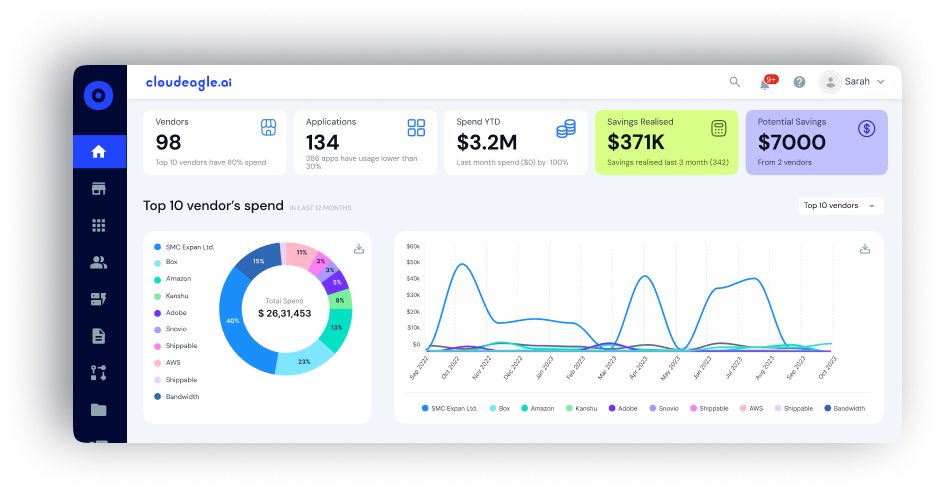
How it helps:
- Stops redundant or duplicate AI subscriptions.
- Flags AI apps purchased via credit cards or free tiers.
- Helps procurement teams regain control over shadow AI spend.
- Surfaces department-level AI usage for better decision-making.
- Lays the foundation for smarter consolidation and pricing.
2. Renewal and Contract Intelligence
CloudEagle.ai tracks AI vendor contracts, renewal dates, pricing terms, and notice periods in a centralized repository. Renewal alerts ensure you never miss opt-out windows or overpay due to auto-renewals.
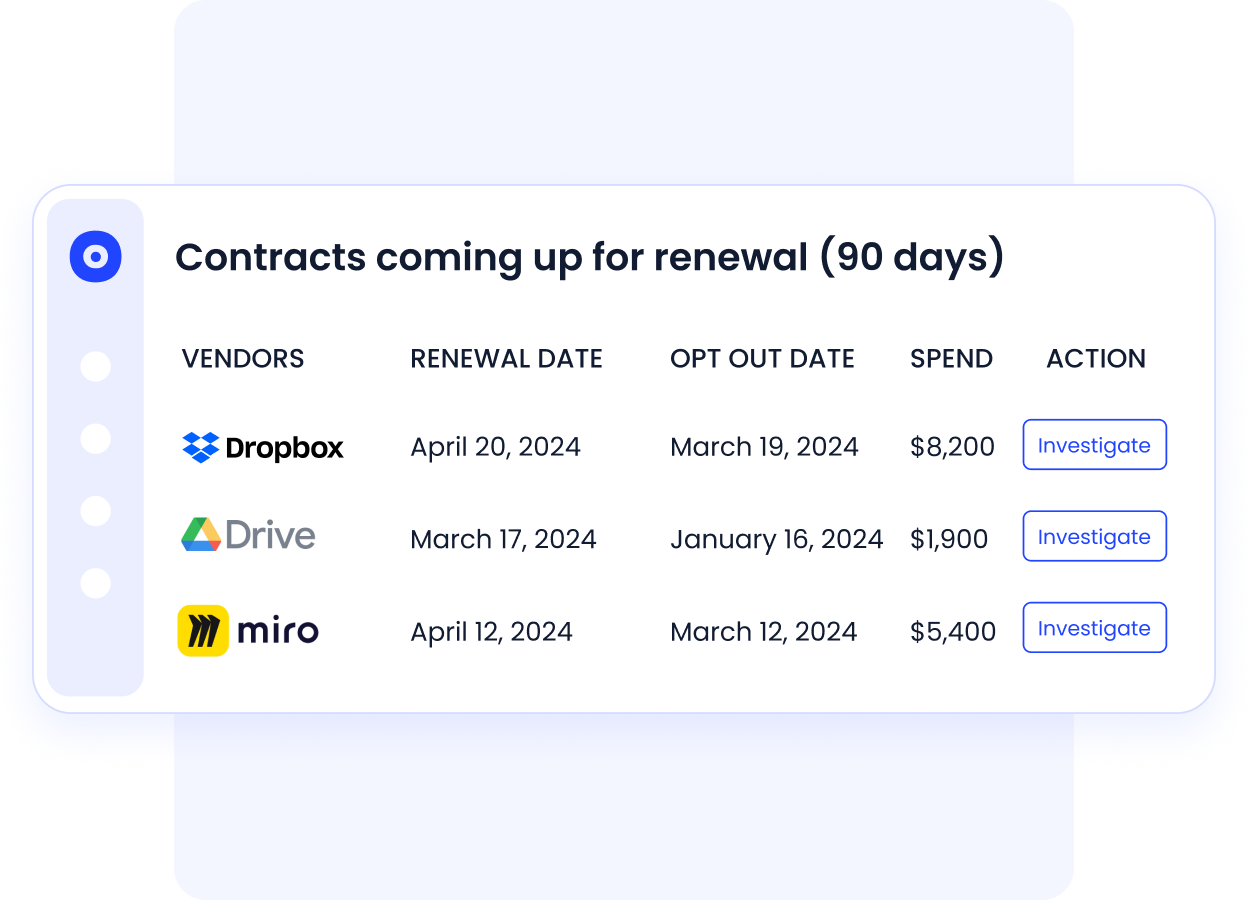
How it helps:
- Avoids surprise renewals and last-minute scrambling.
- Helps teams negotiate from a position of strength.
- Prevents overpayment due to expired discounts.
- Ensures contract SLAs, DPAs, and compliance terms are always available.
- Reduces procurement fatigue with automated reminders.
Explore how DataStax saves nearly $70k through renewal management and procurement services with CloudEagle.ai.
3. AI Pricing Benchmarking
By aggregating anonymized pricing data across industries, CloudEagle.ai provides pricing benchmarks to show what similar companies pay for the same AI tools, helping you push back on inflated quotes.
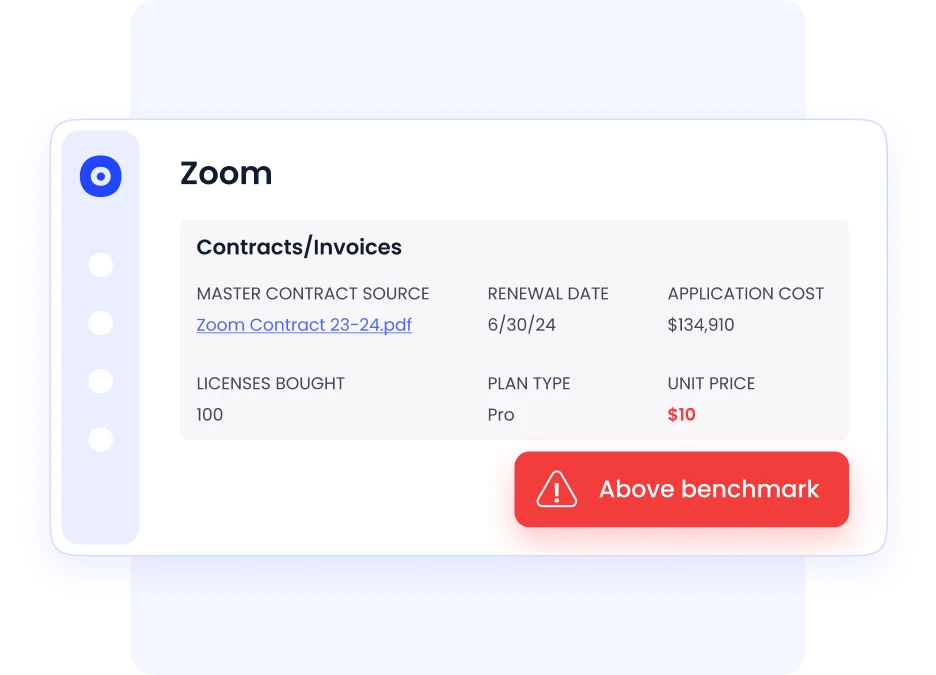
How it helps:
- Equips procurement with real market pricing intel.
- Improves vendor accountability during renewal and negotiation.
- Helps identify overpayment or non-standard pricing.
- Supports internal cost justification to finance leaders.
- Increases leverage in contract renegotiations.
Know how CloudEagle.ai's competitive insights and renegotiations reduced Falkonry’s SaaS spend by 50%.
4. Usage-Based License Optimization
CloudEagle.ai correlates login activity and usage data to licensing tiers, identifying unused or underutilized AI seats, so you only pay for what you actually use.
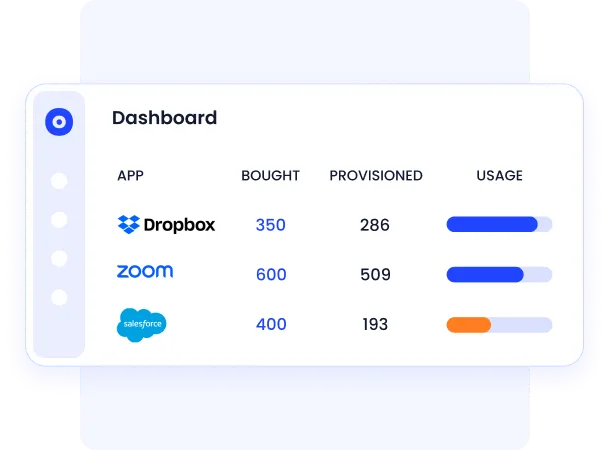
How it helps:
- Eliminates waste from inactive AI licenses.
- Aligns license tiers to actual team usage.
- Enables smarter renewal decisions with usage trends.
- Helps reduce spend without sacrificing productivity.
- Drives adoption insights to boost ROI on AI tools.
5. Procurement Workflow Automation
Streamline AI vendor onboarding with built-in approval workflows involving security, legal, IT, and finance. CloudEagle.ai enforces process compliance while speeding up decision cycles.

How it helps:
- Prevents rogue or unapproved AI tool purchases.
- Automates multi-stakeholder procurement approval.
- Ensures risk, compliance, and security checks are completed.
- Standardizes intake for all AI vendors.
- Speeds up AI adoption with less overhead.
6. Shadow AI Discovery & Risk Alerts
CloudEagle.ai detects unsanctioned AI tools before they become a security or cost problem. Tools installed via browser plugins, credit cards, or freemium trials are flagged for governance.

How it helps:
- Surfaces hidden AI apps early for intervention.
- Helps security and IT enforce authentication standards.
- Prevents sensitive data from leaking into unvetted AI models.
- Supports budgeting accuracy with full AI spend visibility.
- Builds an accurate picture of the total AI tool footprint.
7. Vendor Risk Scoring & Compliance Readiness
Each AI vendor is scored by compliance status, security practices, and usage profile. CloudEagle.ai tracks SOC2, ISO 27001, GDPR, and DPA status, critical when choosing high-risk AI tools.

How it helps:
- Filters out risky AI vendors before purchase.
- Prepares your team for external audits.
- Prevents compliance violations tied to AI usage.
- Gives GRC and security teams a complete audit trail.
- De-risks AI procurement while enabling innovation.
Check out this insightful episode of CloudEagle.ai's SaaS Masterminds podcast, where Karl Haviland explores AI, governance, and approaches for scaling innovation responsibly.
Conclusion
By 2025, AI pricing will be shaped by technological advances and market maturity, influenced by factors like tokens, compute cycles, licensing, and compliance. Understanding these costs is essential for strategic planning and successful AI adoption.
Organizations that track, benchmark, and optimize their AI costs will stay ahead of the competition. Transparent pricing models, efficient usage, and smart vendor negotiations ensure maximum ROI while keeping the cost of artificial intelligence predictable and manageable.
As AI becomes embedded in every business function, understanding the true cost for AI isn’t just a budgeting issue—it’s a competitive advantage.
Ready to get the best AI tools at the right price?
Schedule a demo with CloudEagle.ai and let our experts guide you through the process of optimizing your AI spend.
FAQs
1. How much does AI cost?
AI costs vary depending on the model, usage, and infrastructure. For most businesses, it can range from a few cents per API call to thousands of dollars per month for compute and storage.
2. What is pricing AI?
Pricing for AI depends on how vendors charge for AI services—usually through subscriptions, pay-per-use, or tiered pricing based on model complexity, performance, and token usage.
3. How are AI models priced?
AI models are typically priced per token, API call, or compute time. Providers like OpenAI and Anthropic offer pricing tiers based on model capability and performance, which impacts AI costs.
4. Why is AI so costly?
The high cost of AI comes from factors like compute power, data storage, fine-tuning, and energy usage. As models get more complex, AI costs rise due to increased processing and operational demands.
5. What is the price of AI today?
In 2025, AI costs vary by provider. Entry-level models may cost a few dollars per month, while more advanced enterprise models with fine-tuning and compliance features can cost thousands.

%201.svg)









.avif)




.avif)
.avif)




.png)
